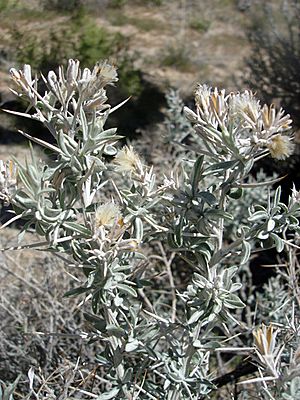Mojave cottonthorn facts for kids
Quick facts for kids Mojave cottonthorn |
|
|---|---|
 |
|
| Conservation status | |
| Scientific classification | |
| Kingdom: | |
| (unranked): | |
| (unranked): | |
| (unranked): | |
| Order: | |
| Family: | |
| Tribe: |
Senecioneae
|
| Genus: |
Tetradymia
|
| Species: |
T. stenolepis
|
| Binomial name | |
| Tetradymia stenolepis Greene
|
|
The Mojave cottonthorn, scientifically known as Tetradymia stenolepis, is a fascinating flowering plant. It's a type of bushy plant that grows in the dry, desert regions of the southwestern United States. This plant gets its common name "cottonthorn" because it looks woolly, almost like cotton, and has sharp, thorn-like leaves. It's a resilient plant, perfectly adapted to survive in its desert environment.
Contents
Discovering the Mojave Cottonthorn
The Mojave cottonthorn is a special plant that belongs to the aster family, which also includes sunflowers and daisies. It's known for its unique look and its ability to thrive in harsh desert conditions.
Where Does It Live?
This plant is native to the deserts where Arizona, Nevada, and eastern California meet. It prefers to grow in sandy or gravelly soil. You can often find it in woodland and scrub habitats, which are areas with small trees and bushes. It's well-suited to dry places.
What It Looks Like
The Mojave cottonthorn is a bushy shrub with many branches. These branches are covered in soft, white, woolly fibers, which give the plant its "cotton" name. It can grow to be a bit over a meter tall, which is about the height of a tall 12-year-old.
Its leaves are narrow and usually about 2 to 3 centimeters long. As they get older, these leaves become hard and turn into straight, sharp spines. You'll also see clusters of woolly leaves growing close to these spines.
Flowers and Fruit
The plant produces small groups of up to seven flower heads. Each flower head is wrapped in four or five woolly leaf-like structures called phyllaries. Inside each head, there are usually four or five yellow, tube-shaped flowers. Each of these tiny flowers is about a centimeter long.
After the flowers bloom, the plant produces fruit. The fruit is a hairy achene, which is a small, dry fruit that contains a single seed. It can be almost 2 centimeters long. The achene has a pappus, which is a tuft of long bristles that helps the seed float away on the wind, like a tiny parachute.


